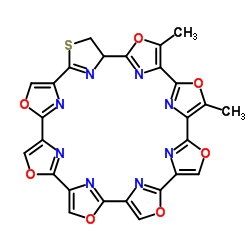265114-54-3
| Name | (±)-Telomestatin |
|---|---|
| Synonyms |
4,8-Dimethyl-3,7,11,15,19,23,27-heptaoxa-31-thia-33,34,35,36,37,38,39,40-octaazanonacyclo[28.2.1.1.1.1.1.1.1.1]tetraconta-2(40),4,6(39),8,10(38),12,14(37), 16,18(36),20,22(35),24,26(34),28,30(33)-pentadecaene
(1<sup>2</sup>Z,2<sup>2</sup>Z,3<sup>2</sup>Z,4<sup>2</sup>Z,5<sup>2</sup>Z,6<sup>2</sup>Z,7<sup>2</sup>Z,8<sup>2</sup>Z)-6<sup>5</sup>,7<sup>5</sup>-dimethyl-8<sup>4</sup>,8<sup>5</sup>-dihydro-1(2,4),2,3,4,5,6,7(4,2)-heptaoxazola-8(2,4)-thiazolacyclooctaphane 3,7,11,15,19,23,27-Heptaoxa-31-thia-33,34,35,36,37,38,39,40-octaazanonacyclo[28.2.1.1.1.1.1.1.1.1]tetraconta-2(40),4,6(39),8,10(38),12,14(37),16,18(36),20, 22(35),24,26(34),28,30(33)-pentadecaene, 4,8-dimethyl- Telomestatin |
| Description | Telomestatin is a very potent telomerase inhibitor and can be isolated from Streptomyces anulatus 3533-SV4. Telomestatin selectively facilitates the formation of intramolecular G-quadruplexes, in particular, that produced from the human telomeric sequence d[T2AG3]4. Telomestatin is an ADC cytotoxin and can be used for cancer research[1]. |
|---|---|
| Related Catalog | |
| Target |
Traditional Cytotoxic Agents |
| In Vitro | Telomestatin (0-50 μM) promotes or stabilizes the formation of the intramolecular G-quadruplex. At the DNA concentrations of 0.005 and 0.2 µM, EC50 values of 0.03 µM and 0.53 µM telomestatin are found. In a parallel experiment with the mutated oligonucleotide d[T2AGAG]4, there is no conversion of the mutated sequence to a G-quadruplex structure by telomestatin[1]. Telomestatin (2-10 μ M) effects the expression of DN-hTERT on telomerase activity and telomere length, at 10 μM,the expression of DN-hTERT shows a significant reduction of telomerase activity. Additionally, at 2 μM , the terminal restriction fragment (TRF) length of U937 cells shortens progressively from 9.5 to 3.8 kb at population doubling (PD) 20 in U937 cells[2]. Telomestatin (2-5 μM; short-time or long trem) has less effect on normal diploid human fibroblasts and ALT-positive cells[2]. Telomestatin (5 μM; short-time 3 days) exposure has no affect the viability of normal human fibroblasts BJ or IMR-90; however, 5 μ M of telomestatin reduces the viability of GM847 cells[2]. Telomestatin (2 μM; long-term 10-50 days) does not significantly change the proliferation rate or viability to that of control cells in BJ or IMR-90 cells and also does not change the proliferation of GM847 cells[2]. |
| In Vivo | Telomestatin ( intraperitoneal injection; 3-15 mg/kg; two times a week; 4 weeks) decreases tumor telomerase activity and inhibits the growth of U937 xenografts. Systemic administrations of 3 mg/kg or 9 mg/kg or 15 mg/kg of telomestatin decreases tumor telomerase activity by 60.2%, 74% and 92.5% compared to control, respectively[2]. Animal Model: Mice model with U937 xenografts[2] Dosage: 3-15 mg/kg Administration: Intraperitoneal injection; 3-15 mg/kg; two times a week; 4 weeks Result: Treated with PBS for 21 days had a mean tumor volume of 1395 mm3 compared with telomestatin treated with a mean tumor volume of 291 mm3. Exhibited no adverse effects (body weight loss, clinical signs or survival). Reduced U937 cells in bone marrow and recovered the normal hematopoiesis in mice. |
| References |
| Density | 2.0±0.1 g/cm3 |
|---|---|
| Molecular Formula | C26H14N8O7S |
| Molecular Weight | 582.504 |
| Exact Mass | 582.070618 |
| PSA | 219.87000 |
| LogP | 0.67 |
| Index of Refraction | 1.962 |
